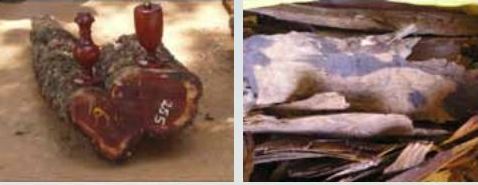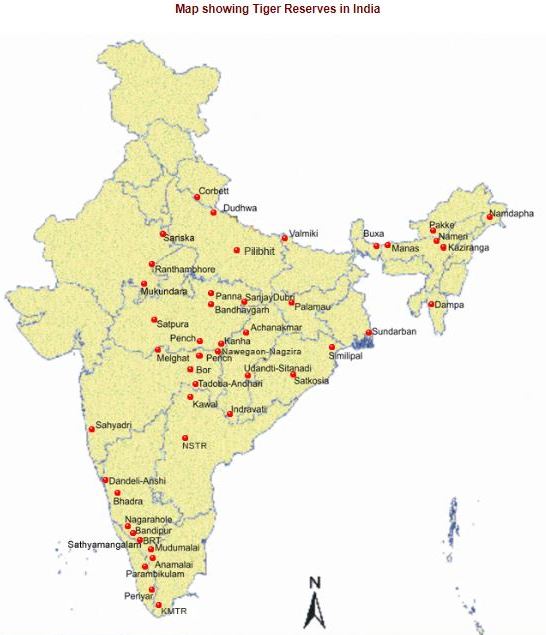Red Sanders
- Pterocarpus santalinus occurs in the Tropical Dry Deciduous Forests.
- It has a highly restrictive distribution in the South Eastern portion of Indian peninsula to which it is endemic.
- It is generally found at altitudes of 150 - 900 m.
- It prefers lateritic and gravelly soil and cannot tolerate water logging.

- It is said to be used in the making of oriental musical instruments like Shamisen, Koto and Erhu and of high demand internationally especially in China.
- Click here to know more about Red Sanders.
Nagarjunasagar-Srisailam Tiger Reserve
- The reserve is situated in the Nallamalais - an offshoot of Southern Eastern Ghats of Andhra Pradesh.
- River Krishna forms northern most boundary of the Tiger Reserve.
- The nomadic, shy, food gathering and hunting primitive tribe "Chenchus" of these hill ranges live in groups called gudems amidst forests of this sanctuary.
- The reserve primarily comprises of southern tropical dry mixed deciduous forest.

- The Nagarjuna sagar- Srisailam wildlife Sanctuary attained the Project Tiger status in 1983, then in 1992, it was renamed as Rajiv Gandhi Wildlife Sanctuary.
- Post bifurcation of the state ,the northern part of the reserve in Telgana state which is called Amrabad Tiger reserve
- Click here to know about Amrabad Tiger Reserve.
National Large Solar Telescope
- National Large Solar Telescope (NLST) is a proposed ground based 2-m class optical and near infra-red (IR) observational facility in the country.
- It is designed to address the scientific issues related to origin and dynamics of solar magnetic fields.
- The instrument has a broad scope to support and substantiate the solar atmospheric observations from space-based ADITYA mission and ground based MAST telescope (Udaipur).
- Click here to know about ADITYA L1 Mission.
The birds and the coffee beans
- In India, coffee acreage has increased by 150% between 1990 and 2015.
- Though Arabica variety of coffee is more flavorful, the planters prefer the Robusta variety which is less resource intensive.
- Arabica is generally grown in shaded, low-intensity areas, while full sun monocultures are common for Robusta cultivation
- To test the differential impact of Robusta and Arabica coffee cultivation on the local ecology, researchers carried out a survey of bird species in the plantation areas.
- The survey points out that Robusta farms generally had the same abundances of bird species as Arabica farms.
- The reason behind it was the dense canopy, landscape-level forest cover and less use of pesticide.
- Arabica plantations were more avian species-rich, bird communities in the Robusta agro forests included many fruit-eating species.
- The survey results suggest that coffee cultivation in the Western Ghats has not been inimical to the ecosystem or the endemic avian population.
Khadi and Village Industries Commission (KVIC)
- The Khadi and Village Industries Commission (KVIC) is a statutory body established by an Act of Parliament1956.
- In 1957, it took over the work of former All India Khadi and Village Industries Board.
- The broad objectives that the KVIC has set before it are
- Social objective: providing employment.
- Economic objective: producing saleable articles.
- Creating self-reliance amongst the poor and building up of a strong rural community spirit.
- Khadi and Village Industries Commission (KVIC) is the nodal implementing agency for Prime Minister Employment Generation program (PMEGP) at the national level.
- Click Here to know about PMEGP
Hubble Space Telescope
- Hubble Telescope has tracked the Neptune’s Mysterious Shrinking Storm.
- It is the world's first large, space-based optical telescope, named in honor of astronomer Edwin Hubble.
- The Hubble is a joint project between NASA and the European Space Agency.
- Sun is the energy source of this space based telescope.
- Some of the interesting Hubble Discoveries are
- Creating a 3-D map of mysterious dark matter.
- Discovering Nix and Hydra, two moons of Pluto.
- Helping determine the rate of the universe's expansion.
- Discovering that nearly every major galaxy is anchored by a black hole.
- Helping refine the age of the universe.
Source: PIB, The Hindu, Business Standard